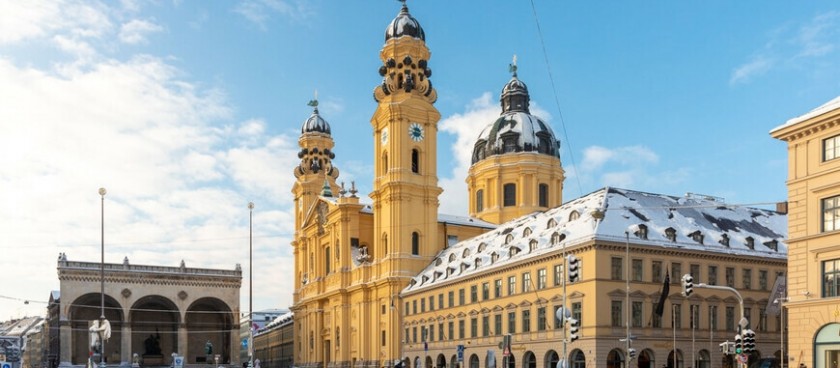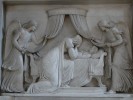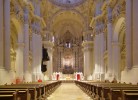- #DE48
- Salvatorplatz 2A, 80333 München, Germany
- +49892106960
- st-kajetan.muenchen@ebmuc.de
- http://www.theatinerkirche.de/
- Working hours*:
Daily from 07:00 to 20:00. - * - opening and closing times as well as entrance prices, are subject to alterations without notice. Visitors are advised to check before visiting.
- 48.1421523, 11.5767081 Copy to clipboard Copy
-
#Churches
The initiator of the construction of this building was Henrietta Adelaide of Savoy, wife of the Bavarian Elector Ferdinand Maria, as a token of gratitude for the birth in 1662 of the Crown Prince, the future Elector Max II Emanuel.
The site for the new, "most beautiful and significant" church was chosen directly opposite the Residence Palace under the city gate of Schwabingertor. According to the Catholic tradition, Saint Cajetan is the patron saint of women in labour, therefore it was this saint who was chosen as the patron of the temple. Saint Cajetan was also the founder of the Teatinian order.
The Church of St. Cayetan was conceived as a court and, at the same time, as a church of the Teatinian Order. Hence the second, unofficial name of the temple - Theatinerkirche, literally translated from German it means “the church of the Treaties”.
The order for the design of the religious building was received by the Italian architect from Bologna, Agustino Barelli. In 1663, the foundation stone was laid for the foundation of the church of St. Cajetan. Barelli designed an Italian Baroque church on the model of the main Roman church of the Teatines, Sant Andrea Della Valle.
Many years of disputes between the author, representatives of the order of the theater and the customers themselves took place about the concrete implementation of the project. So the erection of the temple turned into a long-term construction, and, although still unfinished, the church was consecrated in 1675.
Disagreements over how the Theatinerkirche should look like led to the fact that only 100 years later, work on the design of the building's facade was completed. As a result, the work in the Rococo style was completed by François de Cuvillier the Younger.
The facade of the church is replete with numerous columns and details. In the center, uniting both towers, is the so-called Coat of Arms of the Alliance between the then reigning Maximilian III Joseph and his wife Maria Anna von Sachsen-Pohlen. The dome of the church resembles the dome of St. Peter's Basilica in Rome.
The Teatintsy monastery adjoins the church building. Since the 19th century, the secularized premises of the monastery have housed the ministries of the Kingdom of Bavaria, then the government.
During the Second World War, the church and the monastery were seriously damaged. Already in 1946, restoration work began, and in 1954 the church was transferred to the Benedictine order. The monastery building today houses the Bavarian Ministry of Education.
Interior decoration
The original interior of the Theatinerkirche was so damaged during the Second World War that most of it could not be restored. Therefore, today the interior of the church looks rather modest. The walls of the interior of the temple are painted white.
The fresco on the dome ceiling by J. Schilling in 1764 depicts God the Father as the Creator. In addition, the dome decorated with a 1675 fresco by W. Leutner "The Eight Beatitudes".
There are currently three altars in the church. The painting of the main altar by Gaspard de Crayer depicts the Madonna seated on a throne. The altar in the left nave decorated with a painting by Joachim von Sandrart, which depicts the scene of Saint Cajetan entering the plague-ridden Naples. The painting was painted in dark colours in 1667. The altar of the right nave is decorated with the work of Carlo Sinani in 1676 "The Holy Family".
The church pulpit was made in black oak in 1689 by master Furstenberg. It depicts Jesus with Mary, as well as Saint Caetan and Saint Andrew Avellino.
Crypt
Because the Theatinerkirche was originally conceived as a court church, it is the family burial place of the Wittelsbach dynasty. In the crypt of the temple, the very customer of its construction, Henrietta Adelaide of Savoy, with her husband, Elector Ferdinand Maria of Bavaria, their son Max II Emanuel, only 47 representatives of the family, are buried.
As a rule, only their bodies are kept in metal sarcophagi, and their hearts are traditionally placed in the Altotting Chapel of Graces.
How to get there
The Theatinerkirche located in the heart of Munich. It is easy to get to it from anywhere in the city.
By public transport
All public transport options reach Odeonsplatz or Marienplatz.
Metro: Lines U3, U4, U5, U6 to the Odeonsplatz stop, the metro station located a few meters from Theatinerkirche or the U3, U6 lines to the Marienplatz stop, then about 7 minutes on foot.
City train: Lines S1, S2, S3, S4, S6, S7, S8 to the Marienplatz stop.
Bus: Routes 100, 153 to the Odeonsplatz stop, then a few minutes on foot.
Tram: Line 19 to the Theatinerstrasse stop, then walk along Weinstrasse for a few minutes.
By car
There are several car parks in the Marienplatz area.
Underground garage Parkhaus am Marienplatz at Rindermarkt 16. Open 24 hours a day.
Parking cost:
The first hour is 4 euros,
Each additional hour - 4 euros.
The maximum payment for 24 hours is 30 euros.
Parking for 26 spaces Parkplatz bei Kustermann at Rosental 7. Open Monday to Saturday from 8 am to 9 pm, closed on Sunday.
Parking costs € 6 per hour.
By taxi
The Theatinerkirche in Munich is easily accessible by Uber or München Taxi.




